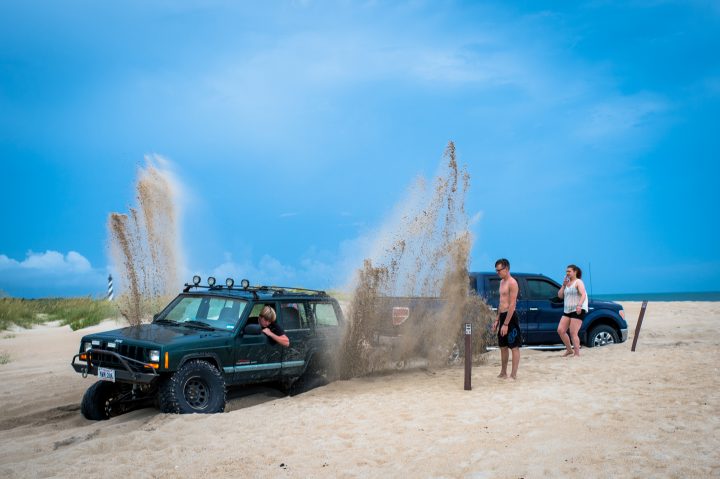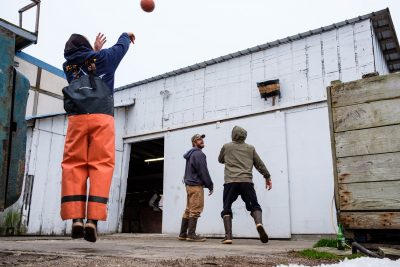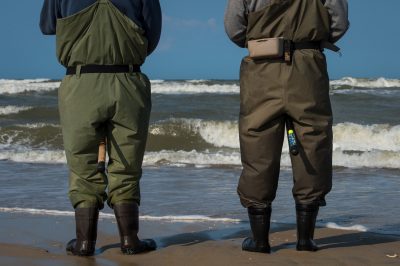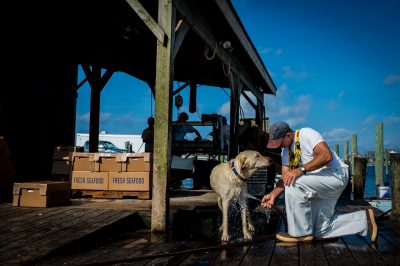
Daniel Pullen’s photographs are remarkable for their diversity: iconic images of the Hatteras Lighthouse or a fisherman on the beach early in the morning baiting his hook. There is a photo of a Jeep stuck on the beach, fantails of sand flying into the air as the driver struggles to free himself.
There are images of watermen and women, not beautiful depictions of a day spent on the water, but rather moments captured in time of a culture and way of life.
Supporter Spotlight

There is also an image of a little girl, her face filled with joy as she rides a wave and just behind her, her mother smiles just as broadly.
“That photo means so much to me,” Pullen said. “That’s my best friend’s wife and daughter in that photograph. That’s where I grew up surfing. That photo for me brings back memories of learning to surf and boogie board.”
“I’d rather focus on telling the story versus just snapping pretty photos or showing the obvious,” he added.
For Daniel Pullen, photography is the pen, ink and paper of the storyteller. Some of his images are joyous, others reveal a glimpse of life on Hatteras Island where he lives. Some are of the mundane, but all his photos tell a story.
“A lot of the time can you tell the whole story in a one picture,” he said. “Sometimes you can’t do it. Sometimes you have to use a group of photographs.”
Supporter Spotlight
It did take him a while, though, to learn how to tell stories with his camera.

He grew up on Hatteras Island, a part of the surf culture and a hopeful artist.
“I was drawing and painting all the time,” he said. “I was doing art shows … and I remember seeing photographers coming here for just a couple of weeks out of the year and they would create these images come back next year with these prints and get it out to book stores and galleries and sell it. And I was like, ‘I live here. They’re here for two weeks and I live here … so I just grabbed a disposable and started taking shots.”
The art background helped but for Pullen, the images he was capturing with a camera held the missing piece of the puzzle.
“The one thing I always struggled with in painting or drawing was composition. With photography it really came relatively easy,” he said.
He eventually bought a single-lens reflex, or SLR, film camera—a Nikon F4—and noticed the difference immediately.
“My photographs may not have gotten better but they looked better,” he said.

If the quality of the images was improving so was Pullen’s understanding of what he wanted to do with photography. He and his wife Kate began shooting weddings, providing him with financial stability; and he found that the camera could do more than just take pictures.
“I love shooting a wedding because you can story-tell,” he said. “That’s easy for me to say because I don’t have to sort through things and edit things. Kate has to do that. I struggle with that and I’m really slow.”
His first weddings were shot with film cameras, as were his early images of surfing and the surf, images that were starting to be noticed for their clarity, vision and composition.
Then the world changed. He had just purchased his latest film camera and was talking to legendary Outer Banks surf photographer Mickey McCarthy about it. Mickey gave him a vision of the future.
“Everybody’s switching over to digital,” he was told.
It took Pullen a while to understand what he had and how to use it. He didn’t have the money for the upper-end equipment. “I couldn’t afford the 500mm lens like Mickey McCarthy had,” he said. But he wanted to be in the water taking pictures, anyway, so a housing for his camera seemed ideal.

“I bought my housing in 2007. I didn’t get a good shot until 2008. I didn’t know what I was doing. There were people I could have called to ask how to use it, but I was just too prideful to ask them,” he recalled.
He was also becoming more interested in the stories that surrounded him than the art shots of a wave or a lighthouse. When McCarthy died in 2016, he realized how important storytelling and people could been photography.
“I was looking through hard drives for photos of Mickey. I realized I only had 12 shots of Mickey. I had hundreds of photos of waves. And waves don’t age, but people do. I hardly have any pictures of Mickey, but I’d spent hours on the beach hanging out with him,” Pullen said.
It is the people that tell the story in his images. Sitting in his Buxton Gallery, he points to an image of a seine net stretched across the beach, reaching into the water to where a boy is standing. The photograph is striking, iconic in its simplicity.
To Pullen, however, it represents a missed opportunity.
“The actual story was he was fishing with his grandfather,” he said. How much better would that have been with the grandson and grandfather there?”

“I’m more focused on or intrigued … by the peripherals, what you don’t necessarily see in a magazine or online. If I have to stand on the beach and shoot, I lose interest as soon as surfers hit the water. If I can get a picture of a guy in the parking lot, of an interaction in the parking lot, that would mean more down the road,” he said.
Almost all of Pullen’s photographs are of Hatteras Island; it is where he grew up and lives. As his skill at telling stories with his camera improves increasingly he sees how important it is to record the changes he is witnessing.
“The original culture here is dying off. It’s slowly fading away,” he said. “With each generation it dies off. It’s one piece of culture that’s not going to be in existence anymore. The way people talk, the way people dress. It’s very important for me to document the culture.”
As he documents that culture, the tales he tells through the lens of his camera continues to evolve and he look for new ways to tell the stories he is seeing.
“As a writer are you writing the same stuff you did five or 10 years ago?” Pullen asks. “Why am I going to revert back and create images that are old to me or are stale?”







